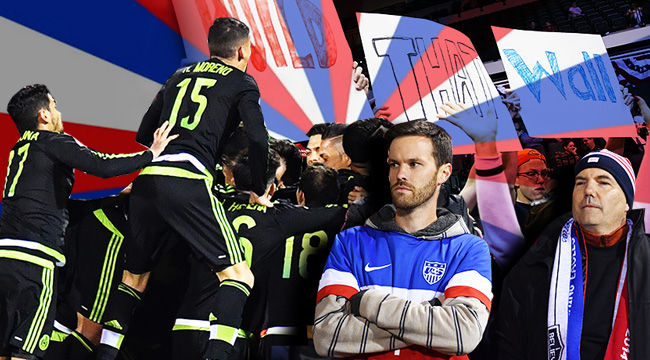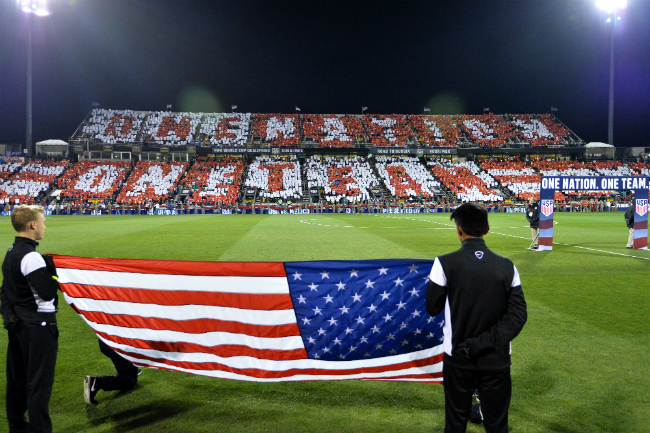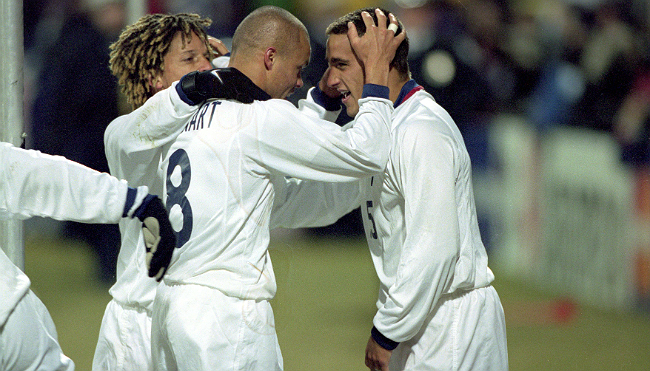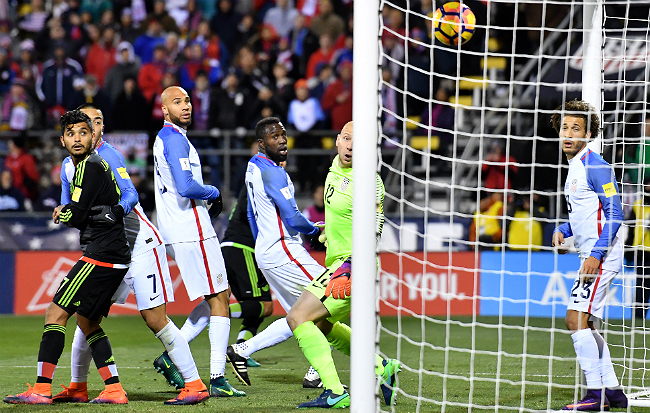
The drive from State College, Pa. to Columbus, Ohio is straight out of a novel on the heartland of America. It’s beautiful, leaves are either changing colors or trees are barren as the calendar has turned to November. There are rolling hills covered in green grass which is just starting to get a hint of brown with winter around the corner. Occasionally, you pass by a small town, but for the most part, it’s a picturesque but kind of boring portion of the country that gets monotonous during a five hour drive.
This is the part of the country that helped Donald Trump become the President-elect of the United States. These small, rural areas outside of places like State College (where I live) or Columbus (the site of the U.S. Soccer vs. Mexico match I am driving to) helped elevate the Republican Party’s nominee to the White House. According to the New York Times, Centre County in Pennsylvania and Franklin County in Ohio went for Hillary Clinton. Everywhere on the highway between those two counties voted for Trump. The drive is littered with Make America Great Again and Trump/Pence signs. This is not unexpected, but residing in and going to places where you mostly only see support for Clinton makes this a little jarring.
The G.O.P. candidate’s rise to the Presidency happened in small towns like these. And the rhetoric used by the President-elect towards Mexico gave quite the subplot to one of international soccer’s biggest rivalries.
———

If you’re an American soccer fan, the three words that make you the happiest are “Dos a Cero.”
Whenever the United States has a big match against Mexico on its home soil, the match takes place in Columbus. MAPFRE Stadium (formerly Columbus Crew Stadium) was the first soccer-specific stadium that an MLS team constructed, and over the years, it’s become the place where the national team is at its best. Prior to Friday’s match, there had been 11 men’s national team matches in the venue. In those matches, the Americans were undefeated: eight wins, three draws, zero losses.
Most notably, when the team needs to play Mexico, the match takes place here, and it ends 2-0. Dos a Cero. This happened four times – in 2001, 2005, 2009, and 2013. After the 2013 win, ESPN’s Ian Darke bellowed, “Lightning doesn’t strike twice in Columbus, Ohio. It’s struck four times.”
Basically, when it was announced that the United States would kick off the Hexagonal – the fifth and final round of CONCACAF World Cup Qualifying during this cycle in which six teams advance, the top-3 qualify for the 2018 World Cup in Rio, and the fourth-place side moves onto a playoff against a team from the Asian Football Confederation – against Mexico, the only thing that made any sense was to hold the match in MAPFRE Stadium.
U.S. Soccer agreed, and on Sept. 6, 2016, it was confirmed that Mexico would have to confront its biggest demon: the United States on its home turf, in a stadium that has spelled doom over their past 11 meetings.
U.S. soccer president Sunil Gulati confirms that Mapfre Stadium in Columbus, Ohio will host U.S.-Mexico on Nov. 11. #usmnt
— Doug McIntyre (@ByDougMcIntyre) September 7, 2016
It was the no-brainer to end all no-brainers. When asked about playing in the venue earlier this year, American captain Michael Bradley said, “This stadium and these people have bailed us out on a lot of occasions.”
———
There have been some concerns about how a Trump presidency would impact some elements of American soccer. For example, U.S. Soccer president Sunil Gulati said this past June that a potential World Cup co-hosted by the United States and Mexico would be “trickier if Secretary Clinton isn’t in the White House.” (It is worth noting that the next World Cup up for grabs is in 2026, when Trump would be out of office, even if he is re-elected. It’s also worth noting that the idea of a split-bid with Mexico isn’t official, but rather, an idea that has been floated.)
Gulati’s stance changed dramatically after Trump’s election. According to Goal.com, Gulati was asked about Trump’s victory and how it would impact a World Cup bid of any kind on Friday, saying, “Perceptions matter, for sure, but I think those will be developed in the months to come, and not only on campaigns. Lots of things get said in campaigns. The meeting that happened yesterday at the White House would not have happened three days earlier, but you have a President and President-elect — they’ve said some interesting things about each other — those are different things than they said yesterday, too, and about each other, and I think the same will be true around the world.”

Plus there’s the whole “Trump’s campaign started by accusing Mexico of illegally sending drugs, crime, and rapists across the border” thing. And the fact that Ohio went red, largely because of the rural counties surrounding the major metropolitan areas like Columbus. If there was any time for America to play Mexico in any sport, it was strangely poetic that it would happen in a swing state three days after Trump got elected.
But the sporting event did what sports always manage to do: let people forget about the real world and have a game be the only thing that matters for a few hours.
———

Feb. 28, 2001. Sept. 3, 2005. Feb. 11, 2009. Sept. 10, 2013.
Those were the four times that the two teams met up in Columbus prior to Friday. All of these matches meant something – every single one was in some round of that cycle’s CONCACAF World Cup Qualifier. Every single one ended with a 2-0 scoreline, and up until Friday, it was viewed as the Mexican soccer team’s little shop of horrors.
The legend started on that freezing cold February day in 2001. It was so cold (it was 29 degrees outside) and hostile that Mexico’s team didn’t even come onto the pitch to warm up, instead choosing to get loose for the match in its locker room.
A decade later, former U.S. international Josh Wolff looked back fondly on that night, which featured the USMNT’s first win in qualifying against Mexico in 21 years.
“It was the beginning of a shifting of the guards as far as our region and for qualifying,” said Wolff, who was the Man of the Match on that evening in 2001 for scoring one goal and assisting on the other. “It’s something we’ve maintained and take great pride in as a country, as U.S. Soccer. Even though I’m not currently with the national team, those are the games that we look forward to watching, and as a player those are the games you look forward to being part of. It’s a good benchmark. It set the stage and helped us grow as a country and enhanced the rivalry to a new level.”
Fast forward 15 and a half years and MAPFRE Stadium has taken on a mythical quality for the USA. It’s kind of like the USMNT’s version of Cameron Indoor Stadium – the place where opposing teams expect to go in, face a raucous crowd, and lose. The crowd did its part on Friday. The team did not.
That doesn’t mean that Columbus isn’t still the United States’ men’s national team’s home field. It just means that America lost. It happens.
———

I want to make one thing clear: like many American soccer fans, there are few things I hate more than Mexico’s soccer team.
Javier “Chicharito” Hernández is one of my least favorite athletes on earth. Giovani dos Santos, Andrés Guardado, Guillermo Ocho, and Héctor Herrera aren’t too far behind. My least favorite Mexican footballer by a country mile is Rafa Márquez, whose Wikipedia page reads, “Throughout his career, Márquez has been criticized by many American analysts and journalists for his history of ‘throwing cheap shots’ at American players.”
So of course, he was the one who eventually drove the dagger into the heart of the USMNT on Friday. Sports are weird like that – they know how to crush you in a way that few other things do. The one thing I could not tolerate was Rafa God Damn Stupid Face I Hate You So Much Márquez beating the United States in Columbus in a World Cup Qualifier.
That, obviously, is what happened. On a personal level, I’m sure everyone who suits up for Mexico is a decent human being. Hell, when Chicharito – the bane of many American soccer fans’ existence – isn’t busy being a footballer, he is a UNICEF Ambassador. That’s admirable! I am very glad he does this and I hope it enriches the lives of children in a way that cannot be articulated, because “I hope good things happen to children” is common sense and does not need to be expanded upon.
But like many sports fans, I struggle to get past the uniforms people wear sometimes. My guess is there were many U.S. supporters like me in the stands on Friday. These people probably understand that, when they aren’t being athletes, they’re human beings. Sports mirror life in that it’s easier to get through everything when you put aside biases and view everyone else as a human above everything else. They also mirror life in that this is really tough for some people to do.
It’s always a fun exercise of self-reflection to watch a sporting event, get mad, and ask yourself why you are getting mad. Usually, it puts into context how dumb hating someone because of the jersey they wear is and reminds you that sports should be fun. This exercise can be done with life, too, but it’s far less fun than when you try to figure out why you dislike a team or athlete so much.
———
The match on Friday wasn’t especially great. The Americans lost, 2-1. Klinsmann threw out a formation that was rather unusual: three defenders, four midfielders, three forwards. The thought process, per the American gaffer, was that it would let the team’s two central midfielders, Bradley and Jermaine Jones, get into 1-on-1 situations. Klinsmann said they didn’t win these battles, Bradley intimated that Klinsmann didn’t give the team proper tactical instructions on how to play in this formation.
This was the first time America busted this 3-4-3 formation out in a competitive match, and despite Klinsmann’s insistence that this worked during training, it crashed and burned. Mexico took an early 1-0 lead, and eventually, the United States scrapped the experiment and switched its formation to a more common 4-4-2. The team started playing much better and managed to grab a goal right at the start of the second half thanks to Bobby Wood, a Hawaii native who plays for a club in Germany and is generally awesome.
Unfortunately for most of the crowd, Marquez scored in the 89th minute to give Mexico the 2-1 lead it would not relinquish. Dos a Cero was impossible after 20 minutes. It looked like we were headed towards Uno a Uno. Instead, we got Dos a Uno. Mexico was the side that netted two goals. It was a gut punch. The United States doesn’t lose in MAPFRE Stadium. Mexico doesn’t win there, either. But on Friday, in what was a fitting end to one of the weirdest weeks in American history, the seemingly impossible happened.
Oh, and as for concerns about chippiness among fans, nothing really awful seemed to happen. My Uber driver dropped me off at the edge of the parking lots, and as I walked in, people were friendly to one another. Music from American radio would fade into music from Mexican radio and vice versa as you walked.
[protected-iframe id=”c3f2b980fc212cca982e150fe874c82b-60970621-76566046″ info=”https://www.dispatch.com/content/mediaplayer/embed.html?ooid=k1bmdqNzE6Fqa0f-MEG01xkCxiXoptFd&cmpid=share” width=”620″ height=”390″ frameborder=”0″ scrolling=”no” allowfullscreen=””]
As fans were leaving their seats, a few Mexico supporters chanted “Dos a Uno,” because of course they’re going to do this. Nothing that will make you lose your faith in humanity happened during the match – all week, my friends and I wondered whether a “Build A Wall” chant would pop up, and while I thought we were being a little too sensitive, I overheard people discussing their fear of this happening this before the match as well.
Thankfully, prior to the start of the match, this happened.
That is all 🇺🇸 🇲🇽 pic.twitter.com/RXZsE3yCCc
— Cristian Nyari (@Cnyari) November 12, 2016
Sure, there was plenty of aggressive play between the two sides – it is a rivalry, after all – but nothing on the pitch was more important than that moment. (Well, Mexico was extra rough with 18-year-old American star Christian Pulisic, and I swear to god if they hurt him I would have sobbed for, like, an hour and a half.)
After the match, there were a few drunk and angry American supporters, but whenever they’d act out, it was: 1) in a way that wasn’t unusual (throwing beer, getting in faces, etc.) and, 2) immediately squashed out by either the cops or other American supporters. Right in front of me, an American fan in the upper row threw a beer at a Mexican fan and was immediately reamed out by another American. A scuffle broke out not long after, but it ended with an American fan diffusing the situation and dapping up the Mexican fans who got singled out.
I saw a person get arrested (it was a Mexico supporter who was taken out of the stadium, put in a cop car, and when asked if he knew anyone on the team responded in Spanish, “all of them”), and a helicopter fly overhead to make sure the police breaking up a parking lot fight were safe. Again, this is all bad, but at a USA vs. Mexico match, it happens. (Also, to be clear: there very well could have been horrific people using deportations as a way to talk smack, I just didn’t encounter or hear about any of this.)
But those were small, isolated incidents. The bigger things that stood out where the moments of camaraderie, the ones where American supporters tailgated with Mexican supporters. They offered congratulations after, because they know what it’s like to win in Columbus and saw how happy people who traveled thousands of miles were that their trip wasn’t for naught for the first time. They took pictures with this one Mexico supporter who dressed in this costume:
The whole Trump subplot ended up being all for naught. At the end of the day, all that mattered was the game. America lost. It was fine. And the next time the USMNT has a big match against Mexico, it will probably take place in Columbus, because that’s just how this works. Sure, it’s possible that Mexico would win again, but ask almost anyone and they’d probably tell you that they’d go into that match expecting it to end Dos a Cero.






